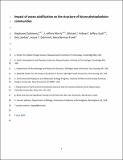Impact of ocean acidification on the structure of future phytoplankton communities
Author(s)
Dutkiewicz, Stephanie; Morris, J Jeffrey; Follows, Michael J; Scott, Jeffery; Levitan, Orly; Dyhrman, Sonya T; Berman-Frank, Ilana; ... Show more Show less
DownloadSubmitted version (602.2Kb)
Publisher Policy
Publisher Policy
Article is made available in accordance with the publisher's policy and may be subject to US copyright law. Please refer to the publisher's site for terms of use.
Terms of use
Metadata
Show full item recordAbstract
Phytoplankton form the foundation of the marine food web and regulate key biogeochemical processes. These organisms face multiple environmental changes, including the decline in ocean pH (ocean acidification) caused by rising atmospheric p CO 2 (ref.). A meta-analysis of published experimental data assessing growth rates of different phytoplankton taxa under both ambient and elevated p CO 2 conditions revealed a significant range of responses. This effect of ocean acidification was incorporated into a global marine ecosystem model to explore how marine phytoplankton communities might be impacted over the course of a hypothetical twenty-first century. Results emphasized that the differing responses to elevated p CO 2 caused sufficient changes in competitive fitness between phytoplankton types to significantly alter community structure. At the level of ecological function of the phytoplankton community, acidification had a greater impact than warming or reduced nutrient supply. The model suggested that longer timescales of competition- and transport-mediated adjustments are essential for predicting changes to phytoplankton community structure.
Date issued
2015-11Department
Massachusetts Institute of Technology. Center for Global Change Science; Massachusetts Institute of Technology. Department of Earth, Atmospheric, and Planetary SciencesJournal
Nature Climate Change
Publisher
Springer Science and Business Media LLC
Citation
Dutkiewicz, S., Morris, J., Follows, M. et al. Impact of ocean acidification on the structure of future phytoplankton communities. Nature Clim Change 5, 1002–1006 (2015).
Version: Author's final manuscript